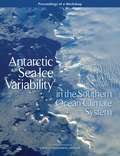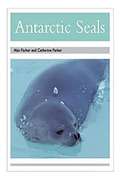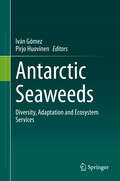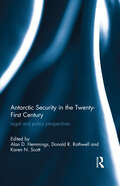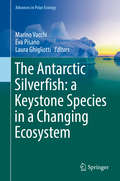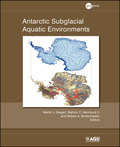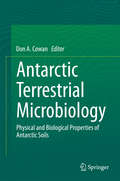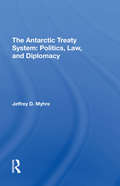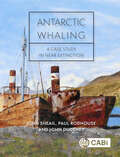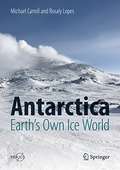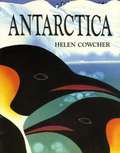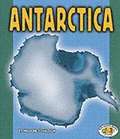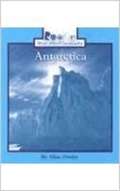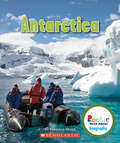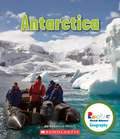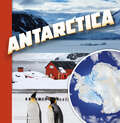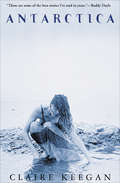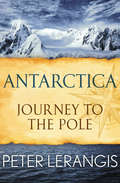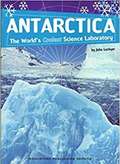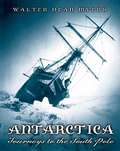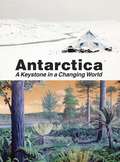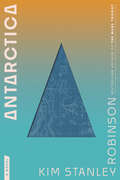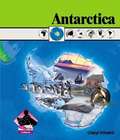- Table View
- List View
Antarctic Sea Ice Variability in the Southern Ocean-Climate System: Proceedings of a Workshop
by Engineering Medicine National Academies of SciencesThe sea ice surrounding Antarctica has increased in extent and concentration from the late 1970s, when satellite-based measurements began, until 2015. Although this increasing trend is modest, it is surprising given the overall warming of the global climate and the region. Indeed, climate models, which incorporate our best understanding of the processes affecting the region, generally simulate a decrease in sea ice. Moreover, sea ice in the Arctic has exhibited pronounced declines over the same period, consistent with global climate model simulations. For these reasons, the behavior of Antarctic sea ice has presented a conundrum for global climate change science. The National Academies of Sciences, Engineering, and Medicine held a workshop in January 2016, to bring together scientists with different sets of expertise and perspectives to further explore potential mechanisms driving the evolution of recent Antarctic sea ice variability and to discuss ways to advance understanding of Antarctic sea ice and its relationship to the broader ocean-climate system. This publication summarizes the presentations and discussions from the workshop.
Antarctic Seals (Rigby PM Collection Ruby (Levels 27-28), Fountas & Pinnell Select Collections Grade 3 Level Q)
by Alan Parker Catherine ParkerAnimal Facts: Polar Animals. Antarctic Seals by Alan Parker, Catherine Parker.
Antarctic Seaweeds: Diversity, Adaptation and Ecosystem Services
by Iván Gómez Pirjo HuovinenSeaweeds (macroalgae) represent the most striking living components in the Antarctic’s near-shore ecosystems, especially across the West Antarctic Peninsula and adjacent islands. Due to their abundance, their central roles as primary producers and foundation organisms, and as sources of diverse metabolically active products, seaweed assemblages are fundamental to biogeochemical cycles in Antarctic coastal systems. In recent years, the imminence of climate change and the direct impacts of human beings, which are affecting vast regions of the Antarctic, have highlighted the importance of seaweed processes in connection with biodiversity, adaptation and interactions in the benthic network. Various research groups have been actively involved in the investigation of these topics. Many of these research efforts have a long tradition, while some “newcomers” have also recently contributed important new approaches to the study of these organisms, benefiting polar science as a whole. This book provides an overview of recent advances and insights gleaned over the past several years. Focusing on a timely topic and extremely valuable resource, it assesses the challenges and outlines future directions in the study of Antarctic seaweeds.
Antarctic Security in the Twenty-First Century: Legal and Policy Perspectives
by Donald R. Rothwell Alan D. Hemmings Karen N. ScottThe Antarctic Treaty (1959) was adopted for the purpose of bringing peace and stability to Antarctica and to facilitate cooperation in scientific research conducted on and around the continent. It has now been over fifty years since the signing of the treaty, nevertheless security continues to drive and shape the laws and policy regime which governs the region. Antarctic Security in the Twenty-First Century: Legal and Policy Perspectives assess Antarctic security from multiple legal and policy perspectives. This book reviews the existing security construct in Antarctica, critically assesses its status in the early part of the Twenty-First century and considers how Antarctic security may be viewed in both the immediate and distant future. The book assesses emerging new security threats, including the impact of climate change and the issues arising from increased human traffic to Antarctica by scientists, tourists, and mariners. The authors call into question whether the existing Antarctic security construct framed around the Antarctic Treaty remains viable, or whether new Antarctic paradigms are necessary for the future governance of the region. The contributions to this volume engage with a security discourse which has expanded beyond the traditional military domain to include notions of security from the perspective of economics, the environment and bio-security. This book provides a contemporary and innovative approach to Antarctic issues which will be of interest to scholars of international law, international relations, security studies and political science as well as policy makers, lawyers and government officials with an interest in the region.
The Antarctic Silverfish: a Keystone Species in a Changing Ecosystem
by Marino Vacchi Eva Pisano Laura GhigliottiThis book encompasses the body of available scientific information on the notothenioid fish Pleuragramma antarctica commonly known as Antarctic silverfish. This plankton-feeder of the intermediate trophic level is the most abundant fish in the coastal regions of high Antarctica, and plays a pivotal ecological role as the main prey of top predators like seals, penguins, whales and Antarctic toothfish. Broad circum-polar distribution, a key role in the Antarctic shelf pelagic ecosystem, and adaptations makes understanding the species' likely response to environmental change relevant to foresee the potential responses at the local ecosystem level. Additionally, a detailed understanding of the abundance and trophic interactions of such a dominant keystone species is a vital element of informing the development of marine spatial planning and marine protected areas in the Antarctic continental shelf region. Experts in the field provide here unique insights into the evolutionary adaptation, eco-physiology, trophic ecology, reproductive and population ecology of the Antarctic silverfish and provide new clues about its vulnerability in facing the challenges of the ongoing environmental changes.
Antarctic Subglacial Aquatic Environments
by Martin J. Siegert Robert A. Bindschadler Mahlon C. Kennicutt IIPublished by the American Geophysical Union as part of the Geophysical Monograph Series, Volume 192.Antarctic Subglacial Aquatic Environments is the first volume on this important and fascinating subject. With its underlying theme of bridging existing knowledge to future research, it is a benchmark in the history of subglacial lake exploration and study, containing up-to-date discussions about the history and background of subglacial aquatic environments and future exploration. The main topics addressed are identification, location, physiography, and hydrology of 387 subglacial lakes; protocols for environmental stewardship and protection of subglacial lake environments; details of three programs aiming to explore Vostok Subglacial Lake, Ellsworth Subglacial Lake, and Whillans Subglacial Lake over the next 3-5 years; assessment of technological requirements for exploration programs based on best practices for environmental stewardship and scientific success; and knowledge of subglacial lakes as habitats for microbial life and as recorders of past climate and ice sheet change. Its uniqueness, breadth, and inclusiveness will appeal to microbiologists and those interested in life in extreme environments, paleoclimatologists and those interested in sedimentary records of past changes, glaciologists striving to understand how water beneath glaciers affects their flow, and those engaged in developing technology to undertake direct measurement and sampling of extreme environments on Earth and in the solar system.
Antarctic Terrestrial Microbiology: Physical and Biological Properties of Antarctic Soils
by Don A. CowanThis book brings together many of the world's leading experts in the fields of Antarctic terrestrial soil ecology, providing a comprehensive and completely up-to-date analysis of the status of Antarctic soil microbiology. Antarctic terrestrial soils represent one of the most extreme environments on Earth. Once thought to be largely sterile, it is now known that these diverse and often specialized extreme habitats harbor a very wide range of different microorganisms. Antarctic soil communities are relatively simple, but not unsophisticated. Recent phylogenetic and microscopic studies have demonstrated that these communities have well established trophic structuring and play a significant role in nutrient cycling in these cold and often dry desert ecosystems. They are surprisingly responsive to change and potentially sensitive to climatic perturbation. Antarctic terrestrial soils also harbor specialized 'refuge'habitats, where microbial communities develop under (and within) translucent rocks. These cryptic habitats offer unique models for understanding the physical and biological 'drivers' of community development, function and evolution.
The Antarctic Treaty System: Politics, Law, And Diplomacy
by Jeffrey D MyhreBecause negotiations for the Antarctic Treaty were kept secret, the issues that shaped the treaty system have been poorly understood. Dr. Myhre breaks new ground by examining the records of the first Antarctic Treaty Consultative Meetings and evaluating the events of the Special Consultative Meetings on Antarctic Mineral Resources. Introducing the reader to Antarctic politics, Dr. Myhre examines legal and political problems arising from some nations' claims to sovereignty in Antarctica, reviews initial efforts to create an international administration for the region, and studies in detail the terms of the treaty and the rules of procedure for the consultative meetings. Turning to the diplomatic events that molded the treaty system, he concentrates on the issues that emerged in the 1960s: conservation, the role of Meetings of Experts, the position of the Scientific Committee on Antarctic Research within the treaty system, the obligations of acceding states to uphold previous agreements, and the Consultative Powers' failure to establish an Antarctic Secretariat. Finally, he reviews the two main challenges to the system's survival—mineral extraction and Third World opposition to the present structure.
Antarctic Whaling: A Case Study in Near Extinction
by John Sheail Paul Rodhouse John DudeneyAntarctic Whaling explores how British whalers came to claim so large a share of the whales taken from the Southern Ocean in the first half of the twentieth century, and, more particularly, where, when, how and why the British Government came to play so large a part in whaling history through its endeavour to regulate the whaling grounds.
Antarctica: Earth's Own Ice World (Springer Praxis Books)
by Michael Carroll Rosaly LopesIn 2016, scientist Rosaly Lopes and artist Michael Carroll teamed up as fellows of the National Science Foundation to travel to Mount Erebus, the world’s southernmost active volcano in Antarctica. The logistics of getting there and complex operations of Antarctica's McMurdo Station echo the kinds of strategies that future explorers will undertake as they set up settlements on Mars and beyond. This exciting popular-level book explores the arduous environment of Antarctica and how it is similar to other icy worlds in the Solar System.The bulk of this story delves into Antarctica’s infrastructure, exploration, and remote camps, culminating on the summit of Erebus. There, the authors explored the caves and ice towers on the volcano’s flanks, taking photographs and generating original art depicting scenes in Antarctica and terrestrial analogs on other planets and moons. Readers will see an intimate side of Mount Erebus and Antarctica while surveying the region’s history, exploration, geology, and volcanology, which includes research funded by the National Science Foundation’s United States Antarctic Programs. Richly illustrated with photographs and stunning paintings showcasing the beauty of the harsh continent, the book captures the spirit and splendor of the authors’ journey to Erebus.
Antarctica
by Madeline DonaldsonAntarctica is the coldest place on Earth. the average temperature is -58 degrees F. Brrr! That's why no one lives there. But there are lots of animals. Penguins, Walruses and Polar Bears are well adapted to the chilly climate. Learn more about this fascinating land of ice and snow in this informative book.
Antarctica (Rookie Read-about Geography)
by Allan FowlerThe popular Rookie Books expand their horizons - to all corners of the globe! With this series all about geography, emergent readers will take off on adventures to cities, nations, waterways, and habitats around the worldand right in their own backyards.
Antarctica (Rookie Read-About Geography: Continents)
by Rebecca HirschA harsh and icy land isolated at the far southern reaches of the globe, Antarctica is the most recently discovered of the continents. Rookie Read-About: Continents series gives the youngest reader (Ages 3-6) an introduction to the components that make each continent distinctive and exceptional. Readers will get to know each continents' geography, history, and wildlife.
Antarctica (Rookie Read-About Geography)
by Rebecca E. Hirsch John CottleYoung readers learn about the most remote continent, the people who explore and study there, as well as the animals that live there.
Antarctica: A 4d Book (Investigating Continents Ser.)
by Christine JuarezCome along and investigate the continent of Antarctica. What are its landforms? What animals live there? What do scientists study there? Bring augmented reality to your students by downloading the free Capstone 4D app and scanning for access to awesome videos!
Antarctica
by Claire KeeganCompassionate, witty, and unsettling, Antarctica is the debut collection of one of Ireland's most exciting and versatile new talents. Claire Keegan, winner of several prestigious awards including the William Trevor Prize, writes stories that have a razor-sharp narrative style and unembellished tone, and move from the cruel, hard life of rural Ireland to the hot landscape of the southern United States.From the title story about a married woman who takes a trip to the city with a single purpose in mind-to sleep with another man-Antarctica draws you into a world of obsession, betrayal, and fragile relationships. In "Love in the Tall Grass," Cordelia wakes on the last day of the twentieth century and sets off along the coast road to keep a date, with her lover, that has been nine years in the waiting. In "Passport Soup," Frank Corso mourns the curious disappearance of his nine-year-old daughter and tries desperately to reach out to his shattered wife who has gone mad with grief.Keegan's characters inhabit a world where dreams, memory, and chance can have crippling consequences for those involved. Moving in its quiet intensity, the award-winning Antarctica is a rare and arresting debut.
Antarctica: Journey to the Pole
by Peter LerangisA father and his sons embark on a perilous trek to the ends of the earthIt is May 1909, and the race to the South Pole is on. For years, Jack Winslow has dreamed of conquering the frozen wasteland, but just before he sets sail, his wife dies suddenly. Rather than cancel the voyage, he brings his two grief-stricken sons, Colin and Andrew, on the adventure of a lifetime. Although the teenagers have read widely of the Antarctic and the icy, unforgiving sea that surrounds it, no book could prepare them for the journey ahead. Killer whales, temperatures as low as –100°F, and deadly crushing ice floes are only the beginning of their troubles. To survive this trip, the Winslows will have to set aside their grief and come together as a family. This ebook features an illustrated biography of Peter Lerangis including rare photos and never-before-seen documents from the author&’s personal collection.
Antarctica: The World's Coolest Science Laboratory
by John LockyerAntarctica: The World's Coolest Science Laboratory by John Lockyer.
Antarctica: Journeys to the South Pole
by Walter Dean MyersThe noted author presents a thrilling record of Antarctica and the expedition parties that have uncovered the frozen continent throughout history.
Antarctica: A Keystone in a Changing World
by National Research Council of the National AcademiesAntarctica is the center from which all surrounding continental bodies separated millions of years ago. Antarctica: A Keystone in a Changing World, reinforces the importance of continual changes in the country's history and the impact of these changes on global systems. The book also places emphasis on deciphering the climate records in ice cores, geologic cores, rock outcrops and those inferred from climate models. New technologies for the coming decades of geoscience data collection are also highlighted. Antarctica: A Keystone in a Changing World is a collection of papers that were presented by keynote speakers at the 10th International Symposium on Antarctic Earth Sciences. It is of interest to policy makers, researchers and scientific institutions.
Antarctica: A Year of Science
by Racheal Rice Jeffrey B. FuerstThe continent of Antarctica is a cold and dangerous place, with towering glaciers and deep crevasses. In the summer, temperatures reach highs of only 2 degrees Celsius (36 degrees Fahrenheit), while during the winter, temperatures can reach lows of -60 degrees Celsius (-76 degrees Fahrenheit). Yet every year a few hundred scientists brave the elements to conduct important scientific research. What does it take to make the trip--and survive the winter--in Antarctica? (Set of 6 with Teacher's Guides and Text Evidence Question Card)
Antarctica
by Kim Stanley RobinsonFrom the award-winning author of the Mars Trilogy comes a thrilling new novel. . . . Kim Stanley Robinson, author of the Hugo and Nebula award-winning Mars trilogy, is one of the most original and visionary writers of fiction today. Now, in his latest novel, he takes us to a harsh, alien landscape covered by a sheet of ice two miles deep. This is no distant planet--it is the last pure wilderness on earth. A stark and inhospitable place, its landscape poses a challenge to survival; yet its strange, silent beauty has long fascinated scientists and adventurers. Now Antarctica faces an uncertain future. The international treaty that protects the continent is about to dissolve, clearing the way for Antarctica's resources and eerie beauty to be plundered. As politicians and corporations move to determine its fate from half a world away, radical environmentalists carry out a covert campaign of sabotage to reclaim the land. The winner of this critical battle will determine the future for this last great wilderness. . . .
Antarctica
by Kim Stanley RobinsonFrom the award-winning author of the Mars Trilogy comes a thrilling new novel....Kim Stanley Robinson, author of the Hugo and Nebula award-winning Mars trilogy, is one of the most original and visionary writers of fiction today. Now, in his latest novel, he takes us to a harsh, alien landscape covered by a sheet of ice two miles deep. This is no distant planet--it is the last pure wilderness on earth.A stark and inhospitable place, its landscape poses a challenge to survival; yet its strange, silent beauty has long fascinated scientists and adventurers. Now Antarctica faces an uncertain future. The international treaty that protects the continent is about to dissolve, clearing the way for Antarctica's resources and eerie beauty to be plundered. As politicians and corporations move to determine its fate from half a world away, radical environmentalists carry out a covert campaign of sabotage to reclaim the land. The winner of this critical battle will determine the future for this last great wilderness....From the Paperback edition.
Antarctica
by Cheryl StriveildiA very brief introduction to the geography, plants, and animals of Antarctica.
